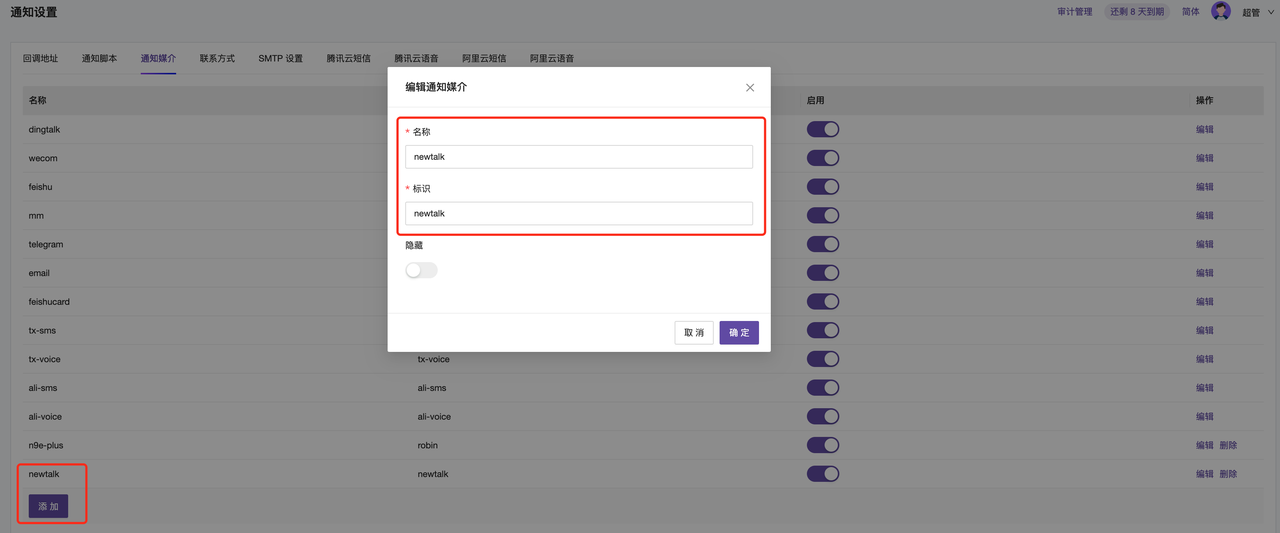夜莺-Nightingale
夜莺V7
夜莺V6
项目介绍
架构介绍
快速开始

黄埔营

安装部署

升级

采集器


使用手册


API


数据库表结构


users
notify_tpl
board
users
target
target
user_group
user_group_member
task_tpl
task_tpl_host
task_record
sso_config
role
role_operation
recording_rule
notify_tpl
metric_view
datasource
configs
chart_share
busi_group
busi_group_member
builtin_cate
builtin_cate
builtin_cate
builtin_cate
board
board_payload
alerting_engines
alert_subscribe
alert_rule
alert_mute
alert_his_event
alert_cur_event
alert_aggr_view
FAQ


转发数据给多个时序库
机器列表数据异常
数据流图
监控数据时有时无
查询原始监控数据
快捷视图详解
告警自愈模块使用
仪表盘里只展示我的机器
仪表盘里图表数据缺失
设置自定义告警通知方式
target_up指标的问题
夜莺可以监控 x 么
夜莺告警常见问题排查思路
告警和恢复的判断逻辑
容量规划问题
connection refused
登录与认证
数据采集器Categraf
日志写到`/var/log/messages`
告警规则&告警模板如何引用变量
采集到的数据是字符串怎么处理
管理员密码忘记了
制作大盘如何添加图片
添加loki数据源报错
v6小版本升级有什么 sql 要执行吗
机器列表有展示,但采集数据查询不到
n9e 启动异常报错
n9e集群部署配置修改
推送 Promethus 报错 OOO
机器列表怎么忽略云资源
告警规则仅在本业务组生效失败
categraf 启动 oracle 插件报错
告警自愈不生效
n9e查询时序库EOF报错
手动编译项目报错
promQL 使用函数标签信息丢失
内存使用率+可用率不等于100
夜莺仪表盘有哪些内置变量
categraf配置文件支持热加载吗
导入 Grafana 仪表盘无效数据源
如何查看报错消息
采集器-Categraf
插件配置
Flashcat 企业版
开源生态
Telegraf
Prometheus
版权声明
第1章:天降奇兵


第2章:探索PromQL


开篇
理解时间序列
Metrics类型
初识PromQL
PromQL操作符
PromQL聚合操作
PromQL内置函数
在HTTP API中使用PromQL
最佳实践:4个黄金指标和USE方法
小结
第3章:Prometheus告警处理


开篇
Prometheus告警简介
自定义Prometheus告警规则
部署Alertmanager
Alertmanager配置概述
基于标签的告警处理路由
使用Receiver接收告警信息

告警模板详解
屏蔽告警通知
使用Recoding Rules优化性能
小结

第4章:Exporter详解


第5章:数据与可视化


第6章:集群与高可用


第7章:Prometheus服务发现


第8章:监控Kubernetes


开篇
初识Kubernetes
在Kubernetes下部署Prometheus
Kubernetes下的服务发现
使用Prometheus监控Kubernetes集群
基于Prometheus的弹性伸缩
小结
第9章:Prometheus Operator

参考资料

通知媒介
通知媒介主要功能有兩個
- 控制哪些通知媒介在告警規則中展示,可以關閉不會用到的聯繫方式,讓通知媒介配置更簡潔
- 用戶可以自己創建新的通知媒介,適配公司自己的通知通道,在自定義通知腳本中根據是否配置了新增的通知媒介來進行相應的通知發送

配置說明
名稱:前台顯示名稱
標識:調用唯一標識
隱藏:是否在告警規則的通知配置中展示
啟用:該通知媒介是否啟用
注意:如果未啟用,則在告警規則配置裡默認不顯示。
使用場景
用戶自己創建的通知媒介和聯繫方式主要在自定義通知腳本中使用,下面是一個腳本調用舉例,可以參考樣例腳本,對接自己的內部通信工具。
系統會把告警事件的內容 encode 成 json,然後通過 stdin 的方式傳給通知腳本,腳本示例如下:
#!/usr/bin/env python
# -*- coding: UTF-8 -*-
import sys
import json
import urllib2
reload(sys)
sys.setdefaultencoding('utf8') # 設置默認編碼為utf-8
class Sender(object):
@classmethod
# 方法send_newtalk,newtalk要和配置的通知媒介一致;
def send_newtalk(cls, payload):
try:
#print("Starting send_newtalk".encode('utf-8'))
# 從payload中獲取事件數據
event = payload.get('event')
# 獲取通知用戶對象
users = event.get("notify_users_obj")
# 獲取告警規則名稱
rule_name = event.get("rule_name")
# 默認事件狀態為 觸發
event_state = "Triggered"
# 如果事件已恢復,則狀態為"恢復"
if event.get("is_recovered"):
event_state = "Recovered"
# 用於存儲Dingtalk機器人令牌和用戶電話
tokens = {}
phones = {}
#print("Extracting user information".encode('utf-8'))
# 遍歷用戶,收集電話和Dingtalk令牌
for u in users:
if u.get("phone"):
phones[u.get("phone")] = 1
contacts = u.get("contacts")
# dingtalk_robot_token,需要根據需求替換對應名稱,在夜鶯通知設置-聯繫方式設定名稱,用戶裡面配置參數
if contacts.get("dingtalk_robot_token", ""):
tokens[contacts.get("dingtalk_robot_token", "")] = 1
# 設置請求頭
headers = {
"Content-Type": "application/json;charset=utf-8"
}
#print("Tokens: {}".format(tokens).encode('utf-8'))
#print("Phones: {}".format(phones).encode('utf-8'))
# 遍歷令牌,構建請求並發送到Dingtalk
for t in tokens:
url = "https://oapi.dingtalk.com/robot/send?access_token={}".format(t)
body = {
"msgtype": "markdown",
"markdown": {
"title": "{} - {}".format(event_state, rule_name),
"text": "{} {}".format(payload.get('tpls').get("dingtalk.tpl", "dingtalk.tpl not found"), ' '.join(["@"+i for i in phones.keys()]))
},
"at": {
"atMobiles": list(phones.keys()),
"isAtAll": False
}
}
#print("Sending request to URL: {}".format(url).encode('utf-8'))
#print("Request body: {}".format(body).encode('utf-8'))
data = json.dumps(body)
req = urllib2.Request(url, data=data, headers=headers)
req.get_method = lambda: "POST"
response = urllib2.urlopen(req)
result = response.read()
#print("Response status code: {}".format(response.getcode()).encode('utf-8'))
#print("Response text: {}".format(result).encode('utf-8'))
# 捕獲所有異常,防止程序崩潰
except Exception as e:
#print("Error in send_newtalk: {}".format(e).encode('utf-8'))
def main():
try:
#print("Reading payload from stdin".encode('utf-8'))
payload = json.load(sys.stdin)
with open(".payload", 'w') as f:
f.write(json.dumps(payload, indent=4))
#print("Payload written to .payload file".encode('utf-8'))
for ch in payload.get('event').get('notify_channels'):
send_func_name = "send_{}".format(ch.strip())
#print("Processing channel: {}, function name: {}".format(ch, send_func_name).encode('utf-8'))
if not hasattr(Sender, send_func_name):
#print("Function {} not found".format(send_func_name).encode('utf-8'))
continue
send_func = getattr(Sender, send_func_name)
send_func(payload)
except Exception as e:
print("Error in main: {}".format(e).encode('utf-8'))
def hello():
print("hello nightingale".encode('utf-8'))
if __name__ == "__main__":
if len(sys.argv) == 1:
main()
elif sys.argv[1] == "hello":
hello()
else:
print("I am confused".encode('utf-8'))
示例腳本中有很多 print 打印的輸出,主要是為了方便調試使用。如果開啟,可通過 n9e 的日誌進行查看,日誌調試在 INFO.log,報錯狀態在 ERROR.log,過濾關鍵詞 event_script_notify。





